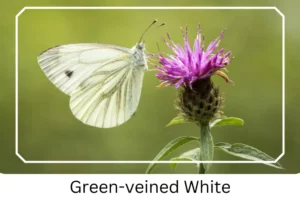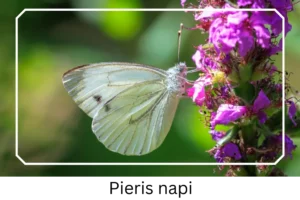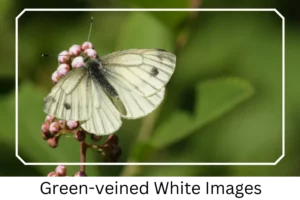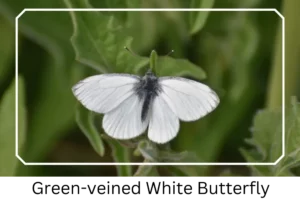Green-veined White (Pieris napi)
The Green-veined White (Pieris napi) is a captivating butterfly species, celebrated for its distinctive green-veined wings against a pristine white backdrop. This butterfly graces various landscapes across Europe and Asia, offering a glimpse into the intricate beauty of nature. Through understanding its lifecycle, habitat, and behaviors, we can appreciate the delicate balance of ecosystems where the Green-veined White thrives.
Scientific Classification
- Family: Pieridae
- Genus: Pieris
- Scientific Name: Pieris napi
Overview
Belonging to the family Pieridae, the Green-veined White butterfly exhibits a fascinating blend of beauty and resilience. This species adapts to a range of environments, demonstrating the remarkable versatility of butterflies. As we delve into the details of its physical characteristics and lifecycle, the Green-veined White emerges as a symbol of nature’s intricate designs and the subtle interplay between flora and fauna.
Description and Identification
Caterpillar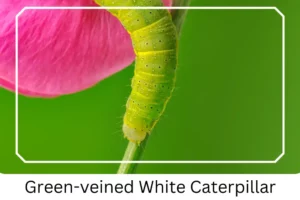
The journey of the Green-veined White begins with its caterpillar stage. The mature larva sports a vibrant dark green hue, adorned with a faint line on each side running the length of its body. This camouflage enables it to blend seamlessly with foliage, evading predators as it feeds and grows.
Pupa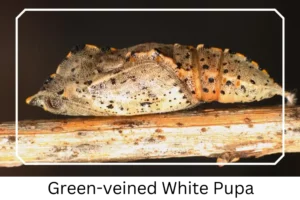
Transitioning into the pupa stage, the chrysalis mirrors the green of its surroundings, with raised parts accentuated in bright yellowish and brown tones. Following the footsteps of other Pieris species, the Green-veined White overwinters in this form, awaiting the warmth of spring to emerge as an adult butterfly.
Adult Butterfly
Sexual Dimorphism: Subtle yet distinguishable, sexual dimorphism exists in this species. While both sexes display the characteristic green-veined wings, males and females can be told apart by distinct markings on their dorsal wings.
Color and Appearance: In flight or at rest, the adult Green-veined White showcases its white base and dark green venation. Males feature a single gray spot centrally on their dorsal wings, whereas females flaunt two gray blotches in the same area. The wingtips carry a graceful gray, enhancing their elegance. The underside reveals a soft yellowish-green hue, blending beautifully with their natural habitat.
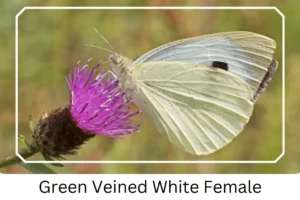
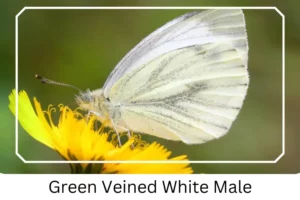 Average Wingspan: The wingspan of the Green-veined White can reach up to 50 mm (1.96 in), allowing for a flight that ranges from medium to brisk speeds.
Average Wingspan: The wingspan of the Green-veined White can reach up to 50 mm (1.96 in), allowing for a flight that ranges from medium to brisk speeds.
Flight Pattern: With a flight pattern that varies from medium to fast, this butterfly navigates through its surroundings with agility and grace.
Eggs
The reproductive cycle continues as females lay pale yellow eggs, singly on the upper side of host plants. This strategic placement ensures the next generation’s survival by providing immediate access to nourishment upon hatching.
Quick Facts | |
| Distribution | The Green-veined White is widely distributed across Europe and Asia, extending its presence to the Indian subcontinent, Japan, the Maghreb, and even North America. |
| Habitat | Preferring shady environments, this butterfly is commonly found in forest edges, meadows, hedgerows, and wooded river valleys. |
| Lifespan of Adults | Approximately 1 to 2 weeks. |
| Host Plants | Water-cress stands out as the most common and preferred host plant for the Green-veined White, essential for the growth of its larvae. |
| Adult Diet | Adults primarily feed on flower nectar, sustaining themselves while pollinating plants in their habitat. |
How to Identify Green-veined White Butterfly?
Identifying the Green-veined White amidst the myriad of butterfly species hinges on observing its unique wing patterns and colors. Look for the distinctive green venation set against a white background, a trait that sets it apart from its relatives. The presence of gray spots or blotches on the dorsal wings can also help differentiate between males and females. Notably, the underwings’ yellowish-green tint becomes apparent when the butterfly is at rest, offering a crucial identification clue. Recognizing these features enables enthusiasts to distinguish the Green-veined White from similar species, enriching their nature observation experiences.
Did You Know?
- Butterfly enthusiasts often mistake the Green-veined White for its close cousin, the Small White, due to their similar appearances.
- The Green-veined White’s ability to thrive in diverse climates showcases its adaptability and resilience, making it a subject of interest in ecological studies.
Conclusion
The Green-veined White butterfly is not just a testament to nature’s beauty but also a crucial component of the ecosystems it inhabits. Through understanding and appreciating this species, we gain insights into the broader ecological networks that sustain life. As we continue to explore and protect their habitats, the Green-veined White serves as a reminder of the delicate balance we must maintain to preserve biodiversity for future generations.

